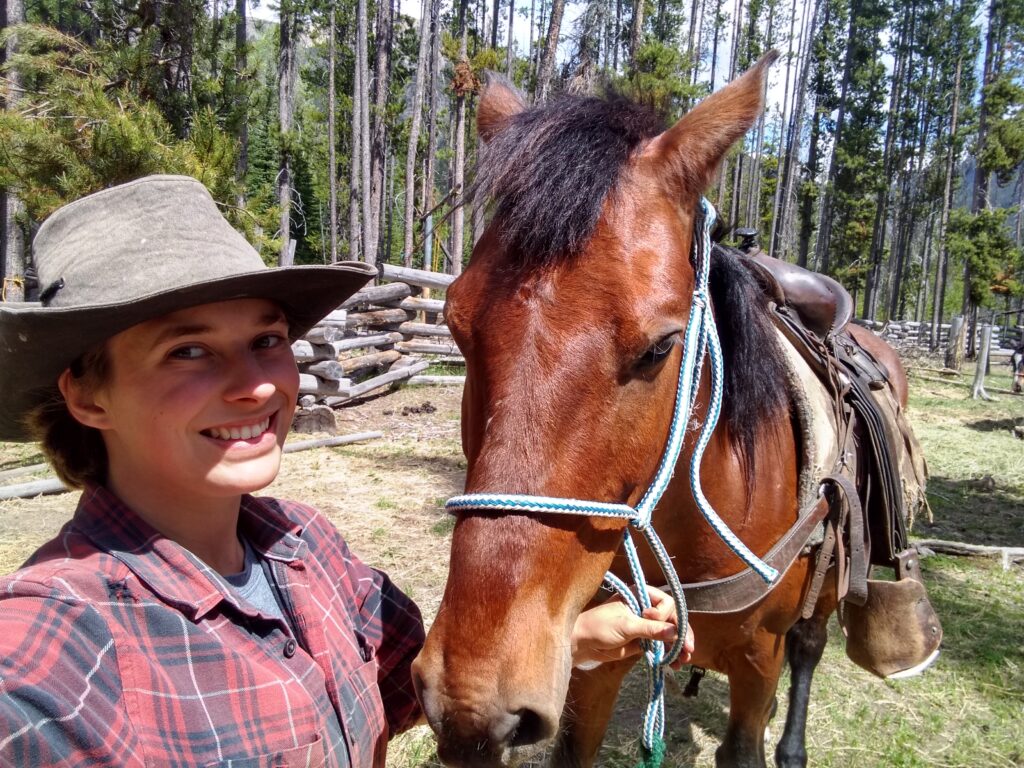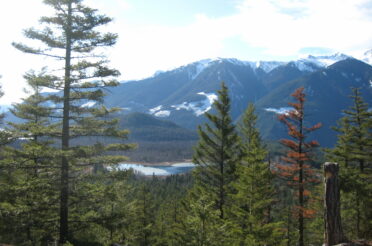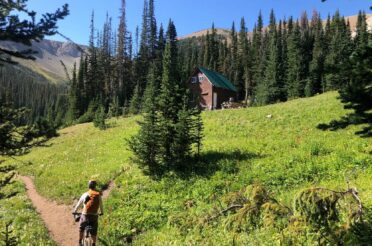Apache – A Wild Horse's Story

Summary: Making the transition from wild horse to calm, stable, reliable riding horse is a huge learning curve. This is Apache’s story of how he became a riding horse. This story is an opportunity to reflect on what you can learn from horses on your own journey. It is also a great opportunity to connect with nature next time you ride a horse through the wilderness.
The process of catching and training wild horses to be calm, stable, reliable riding horses sounds like something out of a Western movie. But it is the true story of how Apache and many of our other horses came to be a riding horse.
Apache was born in the wild. He grew up learning from his mother and the other mares in the herd where to find food, water and shelter. Then the wild horse chasers came, when he was a colt, under three years old, so still living with his herd. The herd were chased, led by the lead mare with the stallion at the back, into a corral. This was done by driving them with riding horses, perhaps along a fence, perhaps through a funnel system, the distance between two fences gradually getting less and less until they were in the corral. The corral had high fences the horses couldn’t jump over.
Apache was driven into a trailer and taken to a wild horse auction. Apache, two other young colts, Marshall and Nean and a young mare, Cheyenne, pregnant with her first foal, were bought by the ranch. The four horses were loaded onto a trailer again and driven three hours over dirt roads to the ranch where they began their new lives.
First, Apache had to learn how to wear a halter and be led by it. Once Apache could be caught with a halter, it was time to get him used to the kind of objects he’d be exposed to on the trail. This included tarps, horse bells, ropes and pack boxes.
Then, we put a saddle and pack boxes on him. We let him run around in the corral to get used to the concept. Soon, he was used to the idea. Now he was ready to be a pack horse on a pack trip. This brought new learning opportunities such as how to walk on a trail, cross a creek and graze in wildflower meadows tied to stake. He also had to learn how to have his feet trimmed and be shod.
Apache has a calm nature and soon was taking all of this in stride. But his one challenge, that still remains, was that he was very hard to catch, running in circles until someone could corner him.
When he’d been a pack horse for a few seasons, I first met Apache. I had him as my pack horse many times. My first season with him, he followed like a lamb. But the second season he started to grumble and harrumph the whole way and kept stopping, sometimes so badly that he’d pull the halter rope out of my hand. I thought he was telling me he was ready to be a riding horse!
So I put a riding saddle on him and led him around so he could get used to the feel of stirrups against his belly and the crouper under his tail. He was unfazed by this so I tried the bridle. Not knowing what to expect, he let me put it on easily. He then chewed the bit for the next ten minutes, wondering what this thing was in his mouth and if he could eat it.
The next time, I put the saddle and bridle on together. He’d soon stopped chewing the bit. I then put my weight in each stirrup, holding onto the saddle so he got the idea of uneven weight distribution as a rider got on. No reaction from Apache so I swung into the saddle. He has no idea what to do so stood perfectly still. This was the sign of a calm, stable, reliable horse. A horse without such a calm nature would have thrown me off or bolted. This was a good sign of his potential.
As a pack horse, Apache was used to being led by the halter. Riding commands of steering with the reins, clicking with the tongue and kicking with the heels meant nothing to him. So Kevan led him with a halter rope and I gave him the riding commands at the same time. Apache was a fast learner and soon was walking in front of Kevan, following my commands instead of being led.
That was as much training as I got to do with Apache before the start of my pregnancy which wasn’t the time to be training green broke horses, no matter how calm he appeared. So Alvis took over the next step of his training. Over the winter, he rode Apache in the deep snow. This is the best time to train new horses as it is harder for them to bolt or throw their rider off. But if you do fall, you have a soft landing. I can attest to this, having been thrown off a new horse a couple winters ago. A couple feet of snow makes a very soft landing.
Apache did amazing over the winter so come the summer, Alvis was riding him on pack trips in the mountains. With Alvis as lead guide, this was a huge learning curve for Apache. Normally the rear guide rides new horses for the first season so the horse can learn from the other horses. But with his years of pack horse experience, Apache knew the trails and how to walk on them.
Every time Alvis and Apache returned from a trip, I had to look twice. Apache was as calm and confident as any of the other horses in the group.
Now we’re back to the winter and deep snow and I could finally get back on Apache. He is still a bit of a challenge to catch, but Lea and I are working on this and he is getting a lot better. Having a purpose as a riding horse seems to help. When I got on Apache, he stood still and was calm throughout the ride. I led with him part of the way and he passed everything with flying colours. He still needs to practice neck reining, but this is a small detail in comparison to his journey from wild horse to calm riding horse.
We had four other inexperienced horses to ride in the deep snow so while I rode these horses, Lea took over riding Apache. Just as it is important for a novice rider to ride lots of different horses to learn how to work with different personalities, it is equally as important for a new horse to have lots of different riders. This helps them learn they are expected to be clam, stable and reliable horses whoever is on their backs. Apache did great with Lea too.
The next time I rode him, I had a hard time remembering that I was riding a horse who, less than two years ago, had never had a person on his back. He was as calm as many of the horses who carried our guests into the mountains.
Although we joke Apache is a guest horse already, he will have several more seasons of being ridden only by guides. Once we know he is able to handle all situations experienced guests will ride him. As he gets older and calmer, any adult guest will be able to ride him. Wit his small size and calm nature I am sure that when he is older and totally bombproof, he’ll make a great kids’ horse.
This is the training cycle of every wild horse who has ever come through the ranch and Apache’s story. If you have the privilege to ride a wild horse, remember this story and the amazing journey that horse has taken to be where they are. We can all learn a lot from horses and this is just one lesson in how to be flexible and adaptable, take on responsibility and get out of your comfort zone.
Charlie



